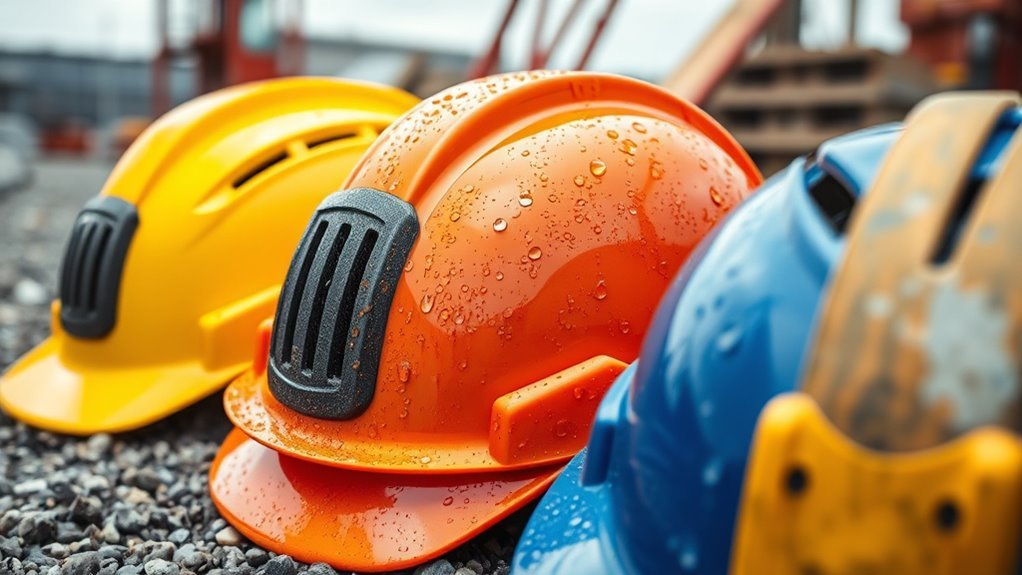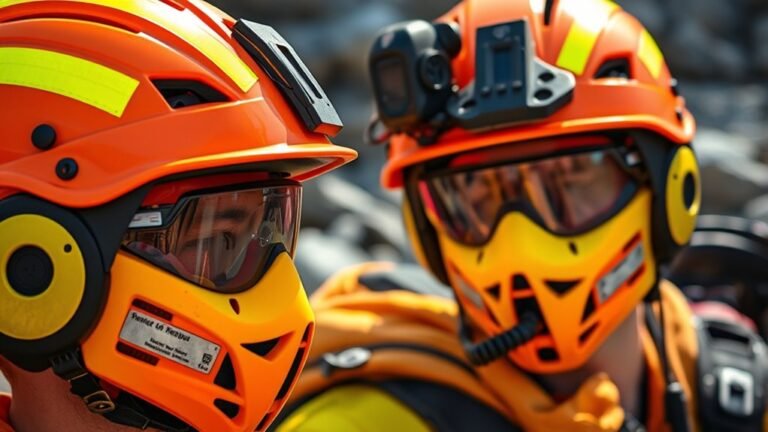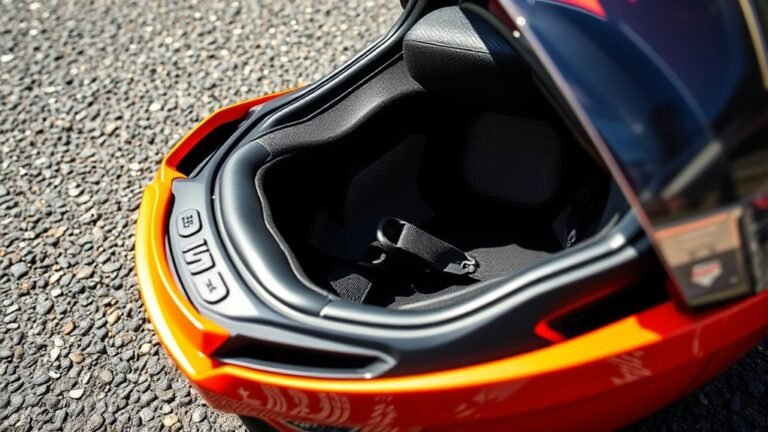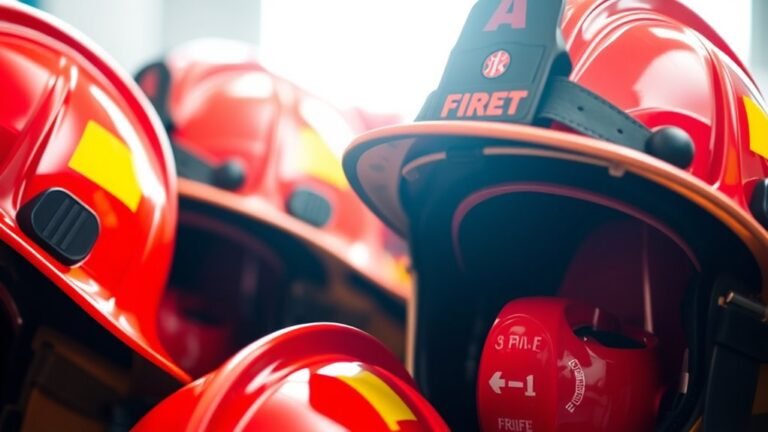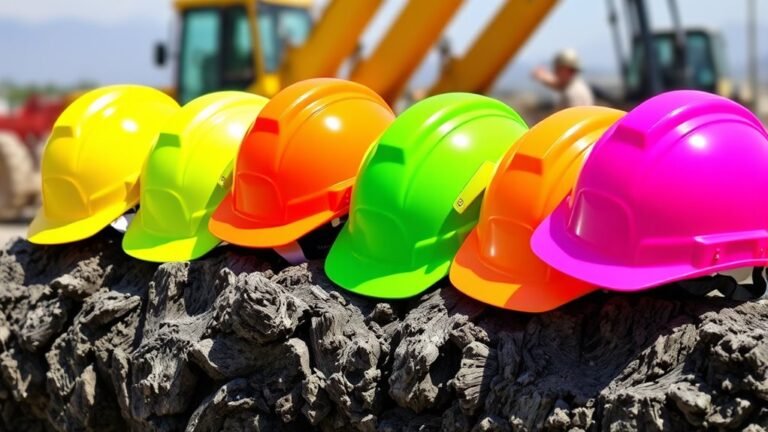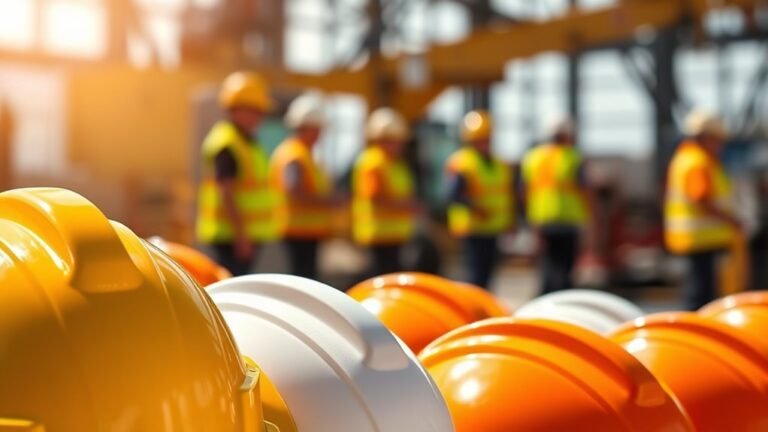Top-Rated Construction Helmets for Harsh Environments
When searching for top-rated construction helmets for harsh environments, prioritize safety certifications like ANSI, ergonomic designs for comfort, and ventilation systems for temperature regulation. Lightweight materials enhance mobility while ensuring durability. Look for adjustable suspensions for a secure fit and helmets with integrated communication options for connectivity. Regular maintenance is key to longevity. Explore options from brands like MSA, 3M, and Pyramex, and discover additional essential features that can enhance your helmet choice.
Key Features to Look for in Construction Helmets
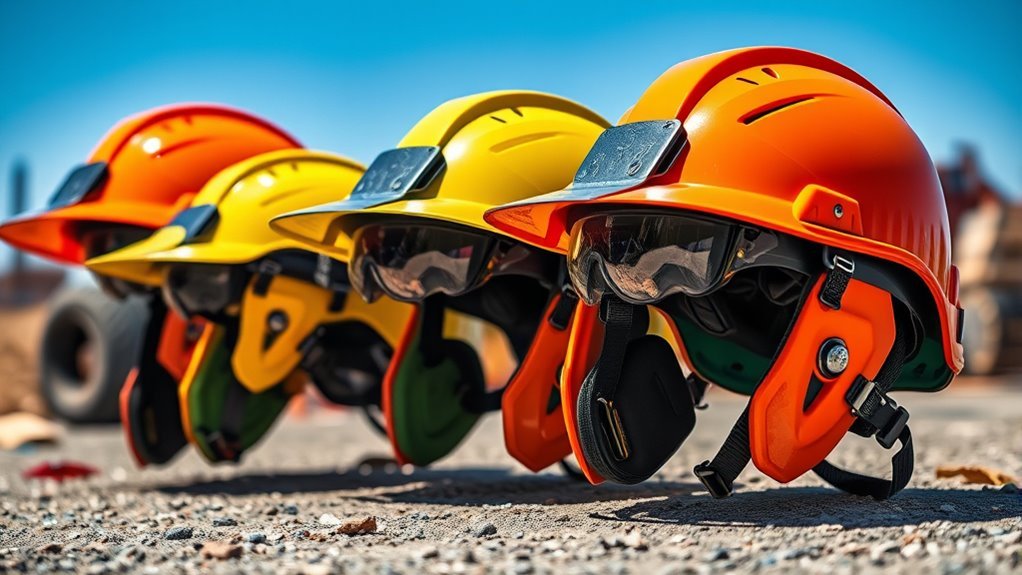
When selecting a construction helmet, it’s essential to evaluate several key features that guarantee safety and comfort on the job site. First, look for advanced safety certifications like ANSI or CSA, which confirm the helmet meets rigorous testing standards. Next, consider an ergonomic design that fits snugly without sacrificing comfort, allowing for extended wear during long hours. Ventilation systems are also important, as they help regulate temperature and reduce sweat buildup. Make certain the helmet has an adjustable suspension system, providing a secure fit regardless of head size. Finally, weigh the helmet’s materials; lightweight options can enhance mobility while maintaining durability. Prioritizing these features will empower you to choose a helmet that meets your safety and comfort needs.
Benefits of Using High-Quality Construction Helmets
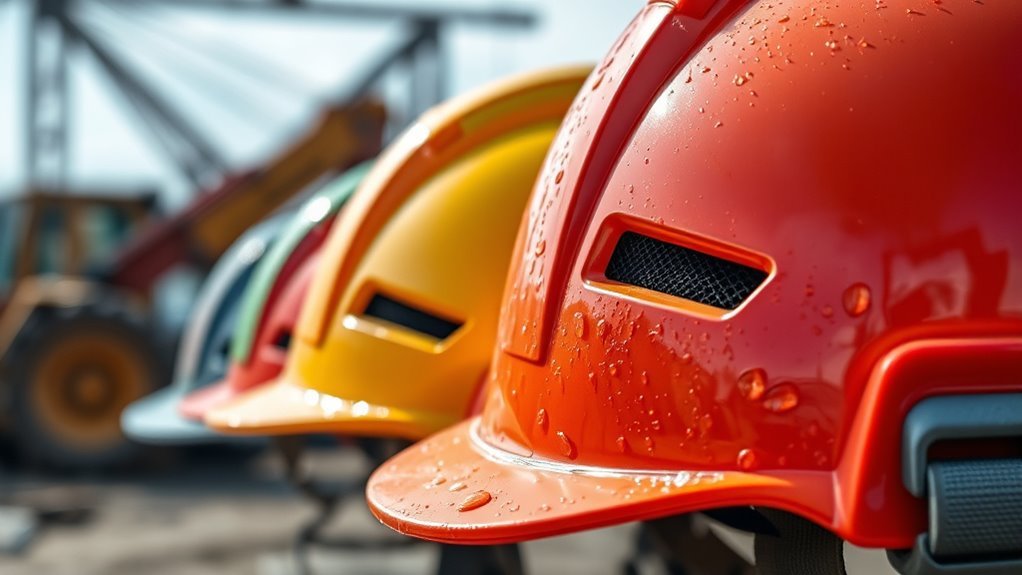
Using high-quality construction helmets not only enhances safety but also contributes to overall job performance. With advanced helmet technology, you get features like impact resistance, lightweight materials, and enhanced ventilation, making your work environment more comfortable. These helmets often incorporate safety innovations such as integrated communication systems and adjustable fit mechanisms, ensuring you stay connected and secure throughout your tasks. Furthermore, high-quality helmets offer superior durability, reducing the frequency of replacements and saving you money in the long run. They also comply with rigorous safety standards, giving you peace of mind as you tackle demanding projects. Ultimately, investing in a reliable helmet means prioritizing your safety and efficiency, allowing you the freedom to focus on your work without worry.
Top Construction Helmets for Extreme Weather Conditions
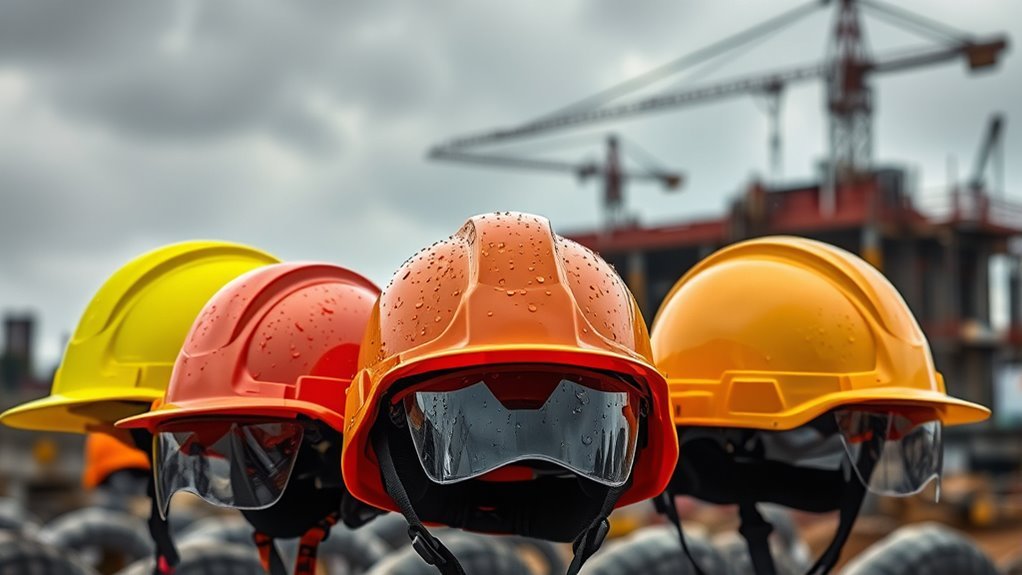
While extreme weather conditions can pose significant challenges on construction sites, selecting the right helmet can make a substantial difference in safety and comfort. Helmets designed for harsh environments often feature extreme weather adaptations, guaranteeing they perform well in both sweltering heat and frigid temperatures. Look for options that incorporate heat resistant materials, which not only maintain structural integrity but also provide comfort during long hours under the sun. Ventilation systems are critical, as they allow airflow, reducing heat buildup inside the helmet. Additionally, consider helmets with moisture-wicking liners to enhance comfort in sweat-inducing conditions. By choosing a helmet tailored for extreme weather, you’ll assure maximum protection and comfort, allowing you to focus on the task at hand without compromising safety.
Impact Resistance: What You Need to Know
When selecting a construction helmet, understanding impact resistance is essential. You’ll need to take into account material durability factors, compliance with safety standards, and the relevant testing and certifications that guarantee optimal protection. These elements collectively determine how well a helmet can safeguard you in hazardous environments.
Material Durability Factors
Understanding material durability factors is essential for selecting a construction helmet that offers ideal protection, especially regarding impact resistance. The right helmet not only safeguards your head but also enhances your confidence on the job. Key aspects to evaluate include:
- Material Composition: Helmets made from high-density polyethylene or fiberglass provide superior strength.
- Environmental Resilience: Resistance to extreme temperatures and UV exposure guarantees longevity under harsh conditions.
- Impact Absorption: A well-designed helmet should effectively dissipate force upon impact, minimizing injury risk.
Safety Standards Compliance
To guarantee ideal protection, it is vital to take into account the safety standards that govern construction helmets, particularly regarding their impact resistance. Compliance with safety regulations is significant, as these standards dictate how well a helmet can withstand impacts. You’ll want to look for helmets that have passed rigorous compliance verification processes.
| Helmet Model | Impact Resistance Rating | Compliance Status |
|---|---|---|
| Model A | High | Verified |
| Model B | Medium | Verified |
| Model C | Low | Not Verified |
| Model D | High | Verified |
Choosing a helmet that meets these standards not only provides peace of mind but also empowers you to work freely and safely in harsh environments.
Testing and Certifications
Testing and certifications play a pivotal role in determining a construction helmet’s impact resistance capabilities. Understanding these processes is essential for your safety in harsh environments. The effectiveness of a helmet is assessed through rigorous testing methods that evaluate its ability to withstand various impact scenarios.
- Helmets must meet specific standards, ensuring your protection against falling objects.
- Certification processes validate that these helmets have undergone thorough evaluations.
- Knowing your helmet’s impact resistance can give you peace of mind on the job.
When choosing a helmet, always look for recognized certifications, as they indicate compliance with fundamental safety criteria. By prioritizing tested and certified helmets, you empower yourself to work confidently, embracing the freedom to tackle any challenging task ahead.
Comfort and Fit: The Importance of Adjustability
While many factors contribute to safety on a construction site, the importance of comfort and fit in helmets cannot be overstated. A well-fitted helmet enhances your safety by guaranteeing it stays securely in place, even during rigorous activities. Look for helmets that offer fit adjustments, allowing you to customize the size for a snug and secure fit. Additionally, comfort padding is vital; it cushions your head, minimizing pressure points and reducing fatigue over long hours. Without proper padding, even the safest helmet can become a nuisance, leading to distractions. Prioritizing adjustability guarantees you can focus on your work without discomfort. Remember, a comfortable helmet not only promotes safety but also supports your productivity on-site.
Ventilation Systems in Construction Helmets
Ventilation systems in construction helmets play a vital role in maintaining comfort and safety on the job site. You’ll find various types of ventilation systems designed to enhance airflow, reduce heat buildup, and prevent moisture accumulation. Understanding these options is essential for selecting a helmet that meets your specific working conditions.
Importance of Ventilation
How essential is proper ventilation in construction helmets? It’s vital for maintaining comfort and safety on the job. Adequate airflow efficiency and temperature regulation can make a significant difference in your performance and well-being.
Consider these key benefits:
- Reduced heat stress: Staying cool helps maintain focus and productivity.
- Increased comfort: A well-ventilated helmet prevents sweat buildup, allowing you to work longer without discomfort.
- Enhanced safety: Improved airflow can reduce the risk of accidents caused by overheating or fatigue.
Types of Ventilation Systems
Many construction helmets incorporate advanced ventilation systems designed to enhance airflow and comfort in demanding environments. These systems generally fall into two categories: active ventilation and passive ventilation.
Active ventilation utilizes powered fans or blowers to circulate air within the helmet, ensuring a constant flow that helps reduce heat buildup and moisture. This system is particularly beneficial in high-temperature settings, providing a more comfortable experience during prolonged wear.
On the other hand, passive ventilation relies on strategically placed vents to promote natural airflow. These vents allow hot air to escape while drawing cooler air in, making them effective in moderate conditions.
Choosing the right ventilation system is essential for maintaining comfort and focus, ultimately enhancing your performance on the job site.
Lightweight Materials for Enhanced Mobility
Although traditional construction helmets often prioritize durability, advancements in lightweight materials now enhance mobility without compromising safety. These innovations allow you to move freely while maintaining protection. With an ergonomic design, these helmets fit snugly, reducing strain during long hours on the job.
Advancements in lightweight materials enhance mobility and comfort in construction helmets, ensuring safety without the burden of weight.
Consider the benefits of these lightweight helmets:
- Enhanced comfort: You won’t feel weighed down, enabling longer work periods without fatigue.
- Increased agility: Move swiftly and confidently in challenging environments, improving overall productivity.
- Improved color visibility: Bright colors guarantee you’re easily seen, enhancing safety on busy sites.
Additional Safety Features to Consider
When selecting a construction helmet, you should prioritize impact resistance ratings to guarantee maximum protection against falling objects. Additionally, consider ventilation and comfort features, as these can greatly affect your wearability during long work hours. Evaluating these aspects will help you choose a helmet that balances safety and comfort effectively.
Impact Resistance Ratings
While selecting a construction helmet, understanding impact resistance ratings is essential for ensuring maximum protection on the job site. These ratings are determined through rigorous impact testing, which evaluates how well a helmet can withstand various forces. By considering the resistance levels, you can make informed choices that enhance your safety.
- Protect yourself from falling objects.
- Reduce the risk of head injuries.
- Work with confidence in hazardous environments.
Choosing a helmet with high impact resistance can mean the difference between a close call and serious injury. Prioritize helmets that have passed stringent tests to guarantee you have the protection you need while enjoying the freedom to focus on your work without fear.
Ventilation and Comfort Features
Given that construction sites can become hot and uncomfortable, it’s important to evaluate ventilation and comfort features when selecting a helmet. Look for helmets that incorporate breathable fabrics; these materials promote airflow, reducing heat buildup during long hours on-site. Moisture-wicking liners are another critical feature, as they draw sweat away from your skin, keeping you dry and comfortable. A well-ventilated design not only enhances comfort but also minimizes distractions, allowing you to focus on your tasks. Additionally, adjustable straps can help achieve a snug fit, further improving comfort levels. By prioritizing these ventilation and comfort features, you’ll guarantee that your helmet not only protects but also supports your well-being in challenging work environments.
How to Maintain and Care for Your Construction Helmet
To guarantee your construction helmet provides maximum protection, it’s essential to implement a regular maintenance routine. Start by using effective helmet cleaning techniques, such as mild soap and water, to remove dirt and grime. Avoid harsh chemicals that can compromise the helmet’s integrity.
Follow these helmet storage tips to prolong its lifespan:
- Store in a cool, dry place away from direct sunlight.
- Keep it free from heavy objects that could cause deformation.
- Inspect the helmet regularly for cracks or wear.
Recommended Brands for Durable Construction Helmets
When it comes to selecting a durable construction helmet, several brands stand out for their commitment to safety and quality. Among the recommended brands, MSA and 3M are often favored for their robust designs and advanced materials. MSA offers helmets with superior impact resistance, while 3M features innovative ventilation systems for comfort. Another strong contender is Pyramex, known for its affordable yet reliable options. For helmet comparisons, consider the weight, fit, and additional safety features like chin straps and face shields. Each brand has unique strengths, so it’s vital to assess your specific needs and environment. Ultimately, choosing a helmet from these reputable brands guarantees you receive both protection and comfort on the job.
Frequently Asked Questions
How Do I Choose the Right Size for a Construction Helmet?
To choose the right size for a construction helmet, start by measuring your head circumference with a tape measure—think of it as fitting a new crown in a medieval joust! Helmet fitting tips include trying on different sizes and guaranteeing it sits level on your head. It shouldn’t wobble or pinch. Use size measurement techniques by checking manufacturer charts, and always opt for a snug yet comfortable fit to guarantee safety.
Are There Construction Helmets Specifically Designed for Women?
Yes, there are construction helmets specifically designed for women, often referred to as female-specific helmets. These helmets cater to the unique fit and comfort needs of women while adhering to safety standards. When choosing a helmet, make certain it meets the required regulations for your industry. Look for features like adjustable sizing and lightweight materials that enhance comfort. This way, you’ll have the freedom to focus on your work without compromising safety.
Can Construction Helmets Be Customized With Logos or Designs?
Yes, construction helmets can be customized with logos or designs. In fact, studies show that branded helmets can increase team morale by up to 30%. When it comes to helmet branding, you’ve got a variety of design options, from stickers to full-color prints. Customization not only enhances identity but also promotes safety culture within your team, making each helmet uniquely yours while ensuring compliance with safety standards.
How Often Should I Replace My Construction Helmet?
You should replace your construction helmet every 3 to 5 years, depending on the helmet lifespan and usage conditions. Regular helmet maintenance, like inspecting for cracks or wear, is essential. If you notice any damage or if the helmet’s been involved in a significant impact, replace it immediately, regardless of age. Keeping your helmet in good condition guarantees maximum protection and helps maintain your safety on the job. Always prioritize your safety!
Are There Construction Helmets Suitable for Electrical Work?
Sure, if you want to play electrical roulette, just grab any old helmet! But really, you need helmets that meet electrical safety standards. Look for helmets specifically designed for electrical work, usually marked with a “Class E” rating. These helmets are engineered to withstand high-voltage situations while providing adequate impact protection. Remember, your noggin’s worth more than a cheap hat! Always prioritize safety over style when it comes to your headgear.
